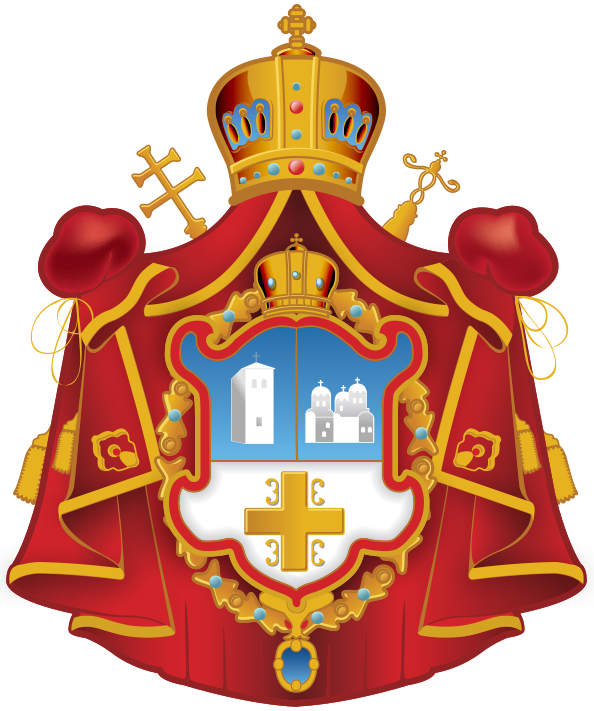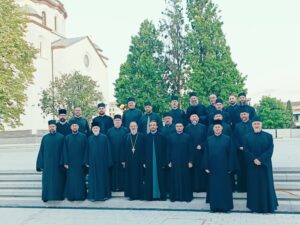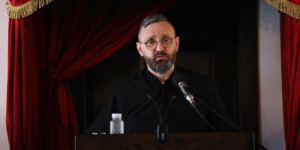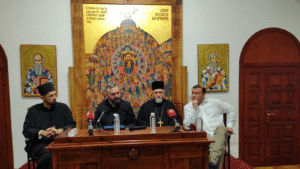We now continue with the interpretation of the Gospel according to Matthew, transitioning into the second chapter. Verses 1 and 2 read as follows:
“Now when Jesus was born in Bethlehem of Judea in the days of Herod the king, behold, wise men from the East came to Jerusalem, saying: Where is He that is born King of the Jews? For we have seen His star in the East and have come to worship Him.”
Blessed Theophylact of Ohrid immediately draws attention to the significance of the phrase “Bethlehem of Judea.” He writes: “Bethlehem, translated, means ‘House of Bread’ (Hebrew Beeyt-Laachem), and Judea means ‘Confession (of God).’” Furthermore, he states that a Christian who confesses God ought to become a house of spiritual bread—that is, of Christ Himself—just as the Lord says: “If a man love me, he will keep my words: and my Father will love him, and we will come unto him, and make our abode with him” (John 14:23).
According to Theophylact, the Evangelist Matthew mentions the reign of King Herod to highlight that the time of the promised Messiah’s arrival had come. This is grounded in the well-known prophecy of the Old Testament patriarch Jacob: “The scepter shall not depart from Judah, nor a lawgiver from between his feet, until He comes to whom it belongs; and to Him shall be the obedience of the peoples” (Genesis 49:10). The Jews no longer had a king of their own lineage—Herod, who ruled over them, was of Idumean origin, and his mother was an Arab. Thus, with only a few words, the Apostle unveils deep truths that might easily escape the reader unfamiliar with the Scriptures.
St. John Chrysostom interprets the words “wise men from the East came to Jerusalem” as a rebuke of the Jews for their indifference to divine revelation. He writes: “Since the Jews, though constantly hearing the prophets proclaiming the coming of Christ, paid no special heed, God called the Gentiles from a far-off land to inquire about the King born among the Jews. They learned from the Persians what the Jews refused to learn from the prophets. God acted thus in order to provide the Jews with the strongest means of conviction—if they were willing—or to leave them without excuse if they remained obstinate. Indeed, what can the Jews say in their defense, when they did not receive Christ after so many prophetic testimonies, while wise men accepted and worshipped Him solely because of the appearance of a star?”
Our own St. Nikolai of Žiča draws attention to the contrast between the fervor of the wise men and the utter apathy of the Jews, writing: “The conceited dignitaries and arrogant scholars of Jerusalem did not deem it necessary even to walk two hours to Bethlehem and see the One whom forty generations from Abraham had awaited. Meanwhile, stargazers from the East, from the dark pagan lands, travelled for months to pay homage to the Christ the King.”
Regarding the identity of the three wise men, the Holy Fathers describe them as learned men from territories that had once been part of the Babylonian Empire. Some suggest they were from Arabia, others from Persia or Babylon itself. St. Nikolai of Žiča aptly summarizes the matter thus: “It is of little importance which specific Eastern lands they came from. What matters most is that they came as representatives of the entire star-worshiping East, to venerate the brightest Star in the sky of human history. This is the message the Evangelist intends to convey—that they came from the East and on behalf of the East, not representing one particular country or people, but the entire Gentile world in worship of the Newborn Lord.”
These men were not astrologers in the modern sense but rather astronomers—scholars dedicated to the study of the stars. According to one tradition, their names were Balthazar, Melchior, and Gaspar, and they later suffered martyrdom for the sake of Christ. Their journey, prompted by the appearance of a mysterious star, is linked by the Holy Fathers to an Old Testament event described in Numbers 24:17, where Balaam, though summoned to curse Israel, instead prophesied under the influence of the Spirit: “I see Him, but not now; I behold Him, but not near. A Star shall come out of Jacob, and a Scepter shall rise out of Israel; it shall crush the forehead of Moab and break down all the sons of Sheth.”
St. Caesarius of Arles on the Motivation of the Magi and the Nature of the Star
St. Caesarius of Arles offers a compelling explanation for the circumstances that prompted the Magi to undertake such a distant and perilous journey:
“If Balaam’s prophecies were included by Moses in the sacred books, how much more thoroughly must they have been recorded by the people of Mesopotamia, where Balaam had gained renown and where his skill, being well established, had found disciples? It is precisely from him that the order of the Magi originates, and it is in the Eastern lands that this knowledge was preserved. They had in their possession records of all that Balaam had prophesied, including the prediction that a star would arise from Jacob and a man would be raised up from Israel. When Jesus Christ was born, the Magi recognized the star and understood that the prophecy had been fulfilled—more swiftly and more clearly than the people of Israel, who received the words of the prophets with indifference. From all that Balaam had left behind in writing, they recognized the time had come; they came, and having found Him, they immediately worshiped Him.”
The star that led the Magi has given rise to numerous patristic insights—first concerning its nature, then in response to arguments made by those who invoke this biblical event to legitimize astrology, and finally regarding the divine purpose behind using a star to set the Magi in motion. Let us explore each aspect in turn.
The Nature of the Star
St. John Chrysostom teaches that the star which led the Magi was, in fact, an angel. He supports this interpretation with several notable observations:
“This was no ordinary star, nor even truly a star at all, but rather—so it seems to me—an invisible power taking the form of a star. This is shown, first of all, by its trajectory. There is no star, and indeed can be no star, that moves in such a path. We observe that the sun, the moon, and all the stars travel from east to west; but this star moved from north to south, since Palestine lies south of Persia. Second, this is proven by the time of its appearance: the star shone not at night, but in broad daylight, under the brightness of the sun—something wholly unnatural not only for stars but even for the moon. The moon, though larger than any star, becomes invisible when the sun is up. But this star outshone the sun and was visible in its full brightness. Thirdly, the star was seen guiding them on their path. When they reached Jerusalem, it vanished. Then, once they had spoken with Herod and resumed their journey, the star reappeared. This was no natural motion of a celestial body, but the behavior of an intelligent force. The star had no fixed course, but would halt whenever needed, guiding the Magi in all things—much like the pillar of cloud that led the Israelites, stopping and going as required.”
A Rebuttal to Astrological Claims
In response to those who seek to justify astrology by citing the appearance of this star, Chrysostom is unequivocal:
“What do the enemies of truth say? They claim: ‘Look, a star appeared at Christ’s birth—therefore, astrology must be a true science.’ But if Christ were truly born under the governance of astrology, how could He have then abolished astrology, rejected fatalism, silenced demons, dispelled delusion, and overthrown all manner of sorcery?”
A Personalized Calling
The calling of the Magi to worship the true God follows a pattern we see elsewhere in the Gospels. Consider, for example, how the apostles—many of whom were fishermen—were called by means of the miraculous catch of fish, as recorded in Luke 5:4–11. In the same manner, as Chrysostom notes, the Magi were called through a star, in accordance with their own field of study and understanding. The Lord, in His infinite condescension, met them where they were.
Here is how St. John Chrysostom explains it:
“You ask me why God led the Magi to Christ by means of such a phenomenon—a star? But how else could it have been done? Should He have sent them prophets? They would not have listened. Should He have given them a voice from heaven? They would have paid no attention. Should He have sent an angel? They would not have obeyed him either. Therefore, God, setting aside such means, in His condescension, employed what was most familiar to them in order to draw them: He revealed a great and wondrous star—so that its very magnitude, splendid appearance, and extraordinary motion would strike them with awe.
Emulating this same principle, the Apostle Paul, when speaking to Gentiles, starts with the familiar – their sacrificial altar and the testimonies from their own poets; when preaching to the Jews, he starts with circumcision—teaching those under the Law by means of the Law. Since everyone is naturally inclined to what is familiar, both God and those He sends for the salvation of the world begin with what people already know and hold dear.”
Adapted and presented for the contemporary reader, based on patristic interpretations, by Stanoje Stanković.





